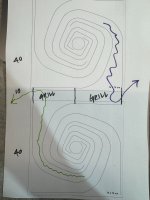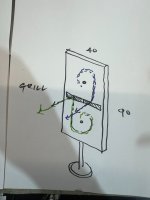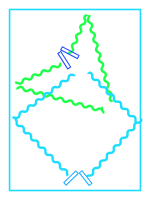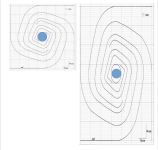Thanks xrk971.
It's not a mechanical or structure issue.
The cone movement in the horn is a fraction of that in free air. So it must be loaded.
I'm not afraid of stirring opinion, having built horns with up to ten foot mouths installed outdoors. And listened to the Fostex and Lowther offerings. It's difficult to separate the psychological like cost from self delusion. All speakers have issues. From 1920, yes they got better quickly. But ribs and crinkles are just twaddle.
LO22B is a very light well made paper cone with polymer coating, it's no worse sounding than the esoteric offerings. The coil is effectively underhung. Like I said I have a stock to play with. I sold some in my horns to HiFi buffs who wanted to compare to electrostatics and their other mortgageable kit, after a blind listening session. A local box manufacturer produced the parts using CAD.
I've tried ferrofluids of various viscosities. Didn't seem to do anything.
Controversially, I suspect that a horn starts acting like a TL somewhere along it's length. And that effects the behaviour of the driver, possibly in the region of the free air resonance in my case. There are too many assumptions in the theory and calculations.
My horn path is circular, no corners. The design is like a thoroughbred, adding wadding or changes to dimensions stops the horn working.
It's not a mechanical or structure issue.
The cone movement in the horn is a fraction of that in free air. So it must be loaded.
I'm not afraid of stirring opinion, having built horns with up to ten foot mouths installed outdoors. And listened to the Fostex and Lowther offerings. It's difficult to separate the psychological like cost from self delusion. All speakers have issues. From 1920, yes they got better quickly. But ribs and crinkles are just twaddle.
LO22B is a very light well made paper cone with polymer coating, it's no worse sounding than the esoteric offerings. The coil is effectively underhung. Like I said I have a stock to play with. I sold some in my horns to HiFi buffs who wanted to compare to electrostatics and their other mortgageable kit, after a blind listening session. A local box manufacturer produced the parts using CAD.
I've tried ferrofluids of various viscosities. Didn't seem to do anything.
Controversially, I suspect that a horn starts acting like a TL somewhere along it's length. And that effects the behaviour of the driver, possibly in the region of the free air resonance in my case. There are too many assumptions in the theory and calculations.
My horn path is circular, no corners. The design is like a thoroughbred, adding wadding or changes to dimensions stops the horn working.
Please try the experiment by forcing since wave step by step until you hear the offending noise. You can find out exactly where it comes from. I suspect it’s an interaction of the horn fundamental 1/4 wave resonance with the suspension Fs. All of this will show up in the impedance sweep as well. There may not be anything you can do about it though unless it’s a horn cabinet vibration. In which cases, adding mass loaded butyl autosound mats and or wooden bracing to stiffen the structure. I have heard and felt 150Hz resonance in my woofers before and adding a strip of mass loaded butyl (Noico) between the magnet and the steep basket stopped it. I added some on the spider of the frame as well. This made a big difference in the sound. But the source was discovered using the methods I described above.

See my XSD thread for details.
See my XSD thread for details.
Hi, thanks, maybe I should have been stating the issue differently, it's not a noise.
The response is not a smooth one.
I used an online sine wave sweep application to confirm this.
I should get it recorded and plot it out, but this is tricky. I suppose if I position mike where I can hear peaks and dips, that would be useful.
Frequency is well above cutoff of the horn mouth dimensions and placement.
Like you suggest, a function of the wavelength interacting with the horn length? Or part thereof, which is what bothers me.
TL or DTL are stuffed with wadding somewhere. Even a taper TL will boom like an organ pipe without wadding.
I'll post up some photos of the inner structure.
Also the curved horn walls have castellated tabs that fit into slots in the front and back plates.
The response is not a smooth one.
I used an online sine wave sweep application to confirm this.
I should get it recorded and plot it out, but this is tricky. I suppose if I position mike where I can hear peaks and dips, that would be useful.
Frequency is well above cutoff of the horn mouth dimensions and placement.
Like you suggest, a function of the wavelength interacting with the horn length? Or part thereof, which is what bothers me.
TL or DTL are stuffed with wadding somewhere. Even a taper TL will boom like an organ pipe without wadding.
I'll post up some photos of the inner structure.
Also the curved horn walls have castellated tabs that fit into slots in the front and back plates.
Hi guys, This forum has been a goldmine of knowledge, thank you.
Before I begin this build I wanted to ask your thoughts.
1- Has anyone stacked two cornu's? I have a room (3x4m 2.5m ceilings) where only a point speaker will work on a pedestal. Image below.
Do you think a stacked pair is worth it, or just run mono?
2- If its worth it, what do you think about two of the eight horns rotating 90 degrees to project out inline with the woofer?
3- Single vs. Double layer. From the last 150 pages it seems the consensus is single layer is preferred given work load. Correct?
4- I was hoping to use these with a small streamer for Spotify etc. Any recommendations?
Thanks everyone! Nicholas.
Before I begin this build I wanted to ask your thoughts.
1- Has anyone stacked two cornu's? I have a room (3x4m 2.5m ceilings) where only a point speaker will work on a pedestal. Image below.
Do you think a stacked pair is worth it, or just run mono?
2- If its worth it, what do you think about two of the eight horns rotating 90 degrees to project out inline with the woofer?
3- Single vs. Double layer. From the last 150 pages it seems the consensus is single layer is preferred given work load. Correct?
4- I was hoping to use these with a small streamer for Spotify etc. Any recommendations?
Thanks everyone! Nicholas.
Attachments
It’s an interesting concept to stack them but that doesn’t help stereo directivity. I think a single driver in mono (combined left and right signal) should work. 3x4m room is quite small.
What about stretching the cornu in one axis to an ellipse for the spirals and rectangular for the box to accommodate two small drivers side by side in center chamber?
What about stretching the cornu in one axis to an ellipse for the spirals and rectangular for the box to accommodate two small drivers side by side in center chamber?
Maybe ceiling-mount with as much L/R separation as possible. If stand-mount, suggest making a wired-pair anyway for flexibility: placed either adjacent, or angled back-to-back bouncing L/R off walls toward listening position.
That is an interesting idea.It’s an interesting concept to stack them but that doesn’t help stereo directivity. I think a single driver in mono (combined left and right signal) should work. 3x4m room is quite small.
What about stretching the cornu in one axis to an ellipse for the spirals and rectangular for the box to accommodate two small drivers side by side in center chamber?
For example, two Failtal Pro 3" sharing the center chamber. Do you think it would be worth worrying about the math on the ellipse, or just 2X in the vertical dimension?
Would you drive them with a mono or stereo amp?
there are a number of to scale drawings in this thread which you can copy and take to a print shop where they can digitally expand for you to what ever overall size you want to build. so no need to do any math to get what you want.Just thinking about doing the math to stretch a Cornu makes my head hurt.
A doubke would increased level capability in the bass. Given the driver spacing you woud need to low-pass one of the drivers. Below a frequency less than that of the quarter-wavelength of the centre-to-centre spacing ofthe drivers. Given the Cornu’s typical bass capability likely best seriesconnectedbwith a big shunt cap.
http://www.planet10-hifi.com/downloads/Dual-Driver-Wiring.pdf
dave
http://www.planet10-hifi.com/downloads/Dual-Driver-Wiring.pdf
dave
That said, would you not want a multiple of the original dimension so the wave length is 2x or 3x etc?there are a number of to scale drawings in this thread which you can copy and take to a print shop where they can digitally expand for you to what ever overall size you want to build. so no need to do any math to get what you want.
Or you think just freestyle it and adjust with stuffing down the line?
Here's what I meant. If using a single two-sided panel the oppisite drivers can be mounted "skew" 30° so as to corner-bounce an equilateral triangle, etc. Even if using separate panels, free-standing or flat against wall, skew-mount (toe-in) can help aim high frequency toward listening position.Maybe ceiling-mount with as much L/R separation as possible. If stand-mount, suggest making a wired-pair anyway for flexibility: placed either adjacent, or angled back-to-back bouncing L/R off walls toward listening position.
(edit: see #2411 @Cal Weldon and #1238 @xrk971)
Attachments
Last edited:
Just stretching it lengthwise will alter the horn throat sizes and tapers, this will create some audible differences from the original design. I don't know much about horns but making the throat go from thin to wide to thin to wide seams like a bad idea. Also the mouths will be of different sizes, this could be good, could be bad...there are a number of to scale drawings in this thread which you can copy and take to a print shop where they can digitally expand for you to what ever overall size you want to build. so no need to do any math to get what you want.
PDF attached with stretched Cornu. It could work, I don't know?
Attachments
Last edited:
I would just stretch it graphically (pull the edge of the image in a paint program). I would run the drivers in left and right stereo to avoid having to use a mono amp. I would not stretch it 2x maybe 1.5x enough to fit the drivers. It’s all fun with foamcore and design is very forgiving so should work fine.
No idea, a fellow from the JoeList. FE206 needs work to help clean up the issues. He used hem with superTweeters adding some issues.

dabe
dabe
The MarkAudio Pluvia Eleven supposedly has better bass, so I pulled the trigger on a pair.
We'll see how they sound in this design. If I don't like it, I can move on to another!
Kind regards,
Drew
We'll see how they sound in this design. If I don't like it, I can move on to another!
Kind regards,
Drew
Cool. Why do they have long wonky tabs on them?The MarkAudio Pluvia Eleven supposedly has better bass, so I pulled the trigger on a pair.
- Home
- Loudspeakers
- Full Range
- Ever think of building a Cornu Spiral horn? Now you can!



